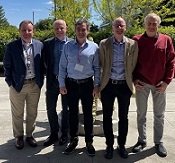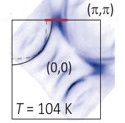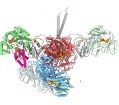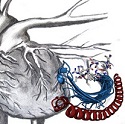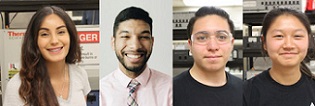
DOE Lightsource Directors Meet at SLAC
SSRL and LCLS recently hosted a meeting of the Directors of the 5 DOE Lightsource User Facilities at SLAC. The group meets periodically to discuss topics of shared interest and hear updates from several standing working groups. Topics for the most recent meeting included data handling, remote access, detector development, industry access and diversity-equity-inclusion (DEI).
Science Highlights
“What is Dead May Never Die” - Fluctuating Superconductivity Illuminates a Path towards Better Superconductors – Contacts: Yu He (Yale University) and Zhi-Xun Shen (Stanford University)
Since the groundbreaking discovery of copper oxide (cuprate) high-temperature superconductors in 1986, the quest to raise the superconducting transition temperature (Tc) in these systems never stopped. However, since the realization of the 135K Tc in Hg-containing cuprates in 1993, the record has remained off-limits to ensuing efforts under ambient conditions. Understanding the mechanisms that limit the superconducting Tc in cuprates has become an imperative task in order to effectively engineer Tc. Read more...
First Atomic Structure of an Intact Polyketide Synthase Revealing Two Asynchronous Reaction Chambers – Contacts: Chu-Young Kim (University of Texas at El Paso), Saket R. Bagde (Cornell University) and Irimpan Mathews (SSRL)
Polyketides are a diverse and important category of molecules with various functions including antibiotic, immunosuppressant, and antitumor. Some polyketides have great medical and economic value. One type of polyketide synthase (PKS), the enzymes that make polyketides, is called type I modular PKS. These are proteins with multiple modules that each contain multiple domains that catalyze different reactions of the polymerization pathway. Read more...
Junctophilin: A Hot Spot for Cardiomyopathy Mutations – Contact: Filip Van Petegem (University of British Columbia)
Junctophilins (JPHs) are protein molecules that initiate junctions between the endoplasmic reticulum or sarcoplasmic reticulum and the plasma membrane of eukaryotic cells, enabling communication. Humans make four isoforms of JPH, which are expressed in different cell types. In heart muscle cells, isoform JPH2 is critical for converting electrical signals to a calcium ion signal that causes the cell to contract. Read more...
More SSRL-Related Science
Scripps Research Discovery could Enable Broad Coronavirus Vaccine
Excerpt from Scripps 2022 Press Release
The COVID-causing virus SARS-CoV-2 harbors a vulnerable site at the base of its spike protein that is found also on closely related coronaviruses, according to a new study from Scripps Research. The discovery could inform the design of broad-acting vaccines and antibody therapies capable of stopping future coronavirus pandemics.
The scientists had previously isolated an antibody from a COVID-19 survivor that can neutralize not only SARS-CoV-2 but also several other members of the family of coronaviruses known as beta-coronaviruses. In the new work, they mapped at atomic scale the site, or “epitope,” to which the antibody binds on the SARS-Cov-2 spike protein. They showed that the same epitope exists on other beta coronaviruses, and demonstrated with animal models that the antibody is protective against the effects of SARS-CoV-2 infection. Read more...
Science Translational Medicine, DOI: 10.1126/scitranslmed.abi9215
San Jose State Undergraduate Students Study Nanodiamonds at SSRL
Excerpt from SLAC News Article by Stephanie Melchor
To Abraham Wolcott, diamonds are so much more than sparkly rocks and status symbols. The San Jose State University physical chemist works with nanodiamonds – that is, nanoscale diamonds made from breaking up larger synthetic diamonds. These nanodiamonds are so small that it takes a row of about 8,000 of them to span the width of a human hair.
What can a chemist like Wolcott do with such miniscule gemstones? Engage undergraduates in advanced research to pursue the chemistry. Read more...
Honors and Awards
2022 Wolf Prize in Chemistry
The 2022 Wolf Prize has been awarded for "for contributions to understanding the chemistry of cellular communication and inventing chemical methodologies to study the role of carbohydrates, lipids, and proteins in such biological processes". Carolyn Bertozzi and Benjamin F. Cravatt III, two of the three recipients awarded this year's prize, have ties to SSRL.
Carolyn Bertozzi, Stanford University, is awarded the Wolf Prize for pioneering biorthogonal chemistry and understanding glycocalyx, and its roles in both health and disease, thus allowing for bioimaging, chemoproteomics, and in-vivo drug delivery.” She has used our SSRL and CryoEM facilities at SLAC as part of her research. Read more...
Benjamin F. Cravatt III, The Scripps Research Institute, "is awarded the Wolf prize for developing activity-based protein profiling, which has emerged as a powerful and widely used chemical proteomic strategy to characterize enzyme function in native biological systems. He used this approach to characterize numerous enzymes which play critical roles in human biology and disease, including the endocannabinoid hydrolases whose lipid products regulate communication between cells.” He has been an author on papers involving work done on SSRL macromolecular crystallography beam lines since 2001. Read more...
Congratulations to Newly Elected AAAS Fellows!
AAAS Fellows for 2021 were announced earlier this year. Election as a Fellow honors members whose efforts on behalf of the advancement of science or its applications in service to society have distinguished them among their peers and colleagues. We are pleased to see members of our SSRL and CryoEM user communities on the list.
AGRICULTURE, FOOD, AND RENEWABLE RESOURCES
José R. Dinneny, Stanford University
BIOLOGICAL SCIENCES
Eva Nogales, University of California, Berkeley
Melanie D. Ohi, University of Michigan
CHEMISTRY
Aimin Liu, The University of Texas at San Antonio
Stephen L. Mayo, California Institute of Technology
MEDICAL SCIENCES
Ann H. West, University of Oklahoma
Events
Symposium to Celebrate 75 Years of Science with Synchrotron Light, April 28, 2022
On Thursday, April 28, 2022, Lightsources.org brings together a panel of light source experts to share their perspectives on synchrotron light related achievements that have been made since the 1st laboratory observation on April 24, 1947. This virtual event will also explore what the future holds for synchrotron science thanks to upgrades and new facilities. Speakers include Nobel Laureate Prof. Ada Yonath (Weizmann Institute of Science), Prof. Sir Richard Catlow (University College London), Prof. Henry Chapman (DESY), Dr. Paul Tafforeau (ESRF), and Dr. Gihan Kamel (SESAME/African Light Source). This 75th anniversary event is organized by Lightsources.org, the international collaboration of 24 synchrotrons and 7 Free Electron Lasers, with support from Diamond Light Source, the UK’s synchrotron science facility. Registration open for 75th Anniversary event on Thursday 28th April – Lightsources.org
Stanford Electron Microscopy-X (EM-X) Virtual Symposium on Monday, May 2, 2022, 8:00–9:30 AM (Pacific Time)
This symposium features Christopher Russo, Group Leader of Laboratory of Molecular Biology, Medical Research Council, Cambridge, UK, with a talk on "Molecular Structure Determination Extrapolated to Zero Dose with an Electron Cryomicroscope," and Peter A. Crozier, Professor at Arizona State University, speaking about, "Fluxionality and Functionality: Relating Atomic-level Temporal Dynamics to Materials Properties". Webinar registration
2022 PULSE/CFEL Ultrafast X-ray Summer School, SLAC, June 20–23, 2022
The school will feature lectures from experts in ultrafast x-ray science. In addition, activities are being planned to further engage students including laboratory sessions aimed at teaching students how to analyze datasets recorded at XFEL facilities. Registration Deadlines: June 1, 2022 (Full Participation); June 18, 2022 (Lectures Only). UXSS2022 website
SSRL/LCLS Users' Meeting, SLAC, September 26–30, 2022 - Save the Date
Planning is well underway for the next joint SSRL/LCLS Users' Meeting to be held September 26–30, 2022. The meeting website should go live soon.
ULITIMA 2022 - Ultrafast Imaging and Tracking Instrumentation, Methods and Applications Conference, SLAC, October 3–6, 2022
Abstract submission is now open for the ULITIMA 2022 - Ultrafast Imaging and Tracking Instrumentation, Methods and Applications Conference, October 3–6, 2022. ULITIMA 2022 website
Announcements
Postdoctoral Opportunities at SSRL
SSRL scientists are looking for post-doctoral candidates for the positions in the areas listed below - find out more about the opportunities at Careers at SLAC.
- Study of Quantum Materials through Resonant X-ray Scattering
- NAWI Postdoc
- Advanced X-ray Characterization of Li-metal and Li-ion Batteries
2022 USPAS Prize for Achievement in Accelerator Science and Technology – Call for Nominations
For more than 35 years, the U.S. Particle Accelerator School Prize for Achievement in Accelerator Physics and Technology has honored scientist and engineers by recognizing their outstanding achievements over the full range of accelerator science and technology. Three prizes will be awarded in 2022, one of the prizes will be awarded to an early-career scientist/engineer under 45 years of age at the time of the award being conveyed and two will be awarded in a "general" category open to all.
Nomination criteria: 1) quality, impact and number of scientific/technical contributions to the field; 2) realization of concepts in working accelerators – leadership and vision in machine building, putting concepts into practice; 3) level of impact – degree to which concepts have led to the production of more or better science or has the potential for doing so in the future; 4) other factors, especially teaching/mentorship/stimulation of young scientists and engineers.
Nominations should include the name, institution and CV of the nominee; description of accomplishments with supporting documents and suggested citation; up to three letters of support in addition to the nominating letter. Letters may have multiple signatures. Nominations are kept for 4 years and may be renewed. Early-career nominees who age-out will be evaluated in the general category. Each winner will receive a certificate of merit and a cash award of $3,000.00. The awards will be presented at NAPAC22 in Albuquerque, New Mexico.
The deadline to submit 2022 USPAS Prize nominations is May 9, 2022. Please submit nominations to uspas@fnal.gov
User Research Administration
Proposal Deadlines
- Xray/VUV - May 1, 2022
- CryoEM biology-related proposals for the S2C2 program are due on the first day of each month and are being reviewed on a monthly basis.
Submit beam time requests and proposals through the User Portal.
The Stanford Synchrotron Radiation Lightsource (SSRL) is a third-generation light source producing extremely bright x-rays for basic and applied research. SSRL attracts and supports scientists from around the world who use its state-of-the-art capabilities to make discoveries that benefit society. SSRL, a U.S. DOE Office of Science national user facility, is a Directorate of SLAC National Accelerator Laboratory, operated by Stanford University for the U.S. Department of Energy Office of Science. The SSRL Structural Molecular Biology Program is supported by the DOE Office of Biological and Environmental Research, and by the National Institutes of Health, National Institute of General Medical Sciences. For more information about SSRL science, operations and schedules, visit http://www-ssrl.slac.stanford.edu.
To unsubscribe from SSRL Headlines, just send an e-mail to listserv@slac.stanford.edu with "signoff ssrl-headlines" in the body.
To subscribe, send an e-mail to with "subscribe ssrl-headlines" in the body.
Questions? Comments? Contact Lisa Dunn

